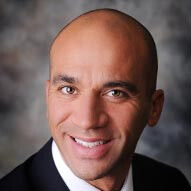Pediatric arteriovenous fistula (AVF)
At Children's Health℠, The Center for Cerebrovascular Disorders in Children offers children and parents a collaborative group of experts that comprehensively diagnose and treat your child’s cerebrovascular disease, such as pediatric arteriovenous fistulas (ar·te·rio·ve·nous - fis·tu·las) or AVFs.
What is a pediatric arteriovenous fistula (AVF)?
Arteriovenous fistulas (AVFs) are rare abnormal connections between an artery and vein. This connection allows blood to flow directly from an artery to a vein rather than travel through capillaries (tiny connecting blood vessels), causing the surrounding brain tissue to not receive the oxygenated blood it needs. AVFs can occur anywhere in the body, but we most commonly see them in the brain, close to its protective lining.
This rare condition can be present at birth or when an artery and vein that are side-by-side are damaged, and the healing process results in the two becoming linked.
The Center for Cerebrovascular Disorders in Children are among the very best in the region at performing the most advanced procedures and therapies for the treatment of pediatric cerebrovascular disease. Each of our primary team members works solely in the pediatric setting with a clinical interest in disorders of the cerebrovascular system.
This program is the only one of its kind in Texas, and one of a handful across the nation. It offers a unique level of expertise in the management and treatment of patients with AVFs specific to children and adolescents. We are the only program in Dallas to offer pediatric neurosurgery and neuro-radiology coverage 24 hours a day by specialized, dedicated pediatric providers.
Please email ccdc@childrens.com to schedule an appointment.
What are the signs and symptoms of a pediatric arteriovenous fistula (AVF)?
The most common symptoms of an AVF are:
Purplish, bulging veins that can be seen through the skin of the head, face, or scalp
Tingling of the arms or legs
Hearing a pulsating sound
Decreased blood pressure
Vision changes
Enlarged head
Fatigue
Heart failure or difficulty breathing
Stroke-like symptoms
Seizures
How is a pediatric arteriovenous fistula (AVF) diagnosed?
If your doctor suspects your child has an AVF, he or she may be able to listen to the blood flow through the area. The blood flow through an arteriovenous fistula makes a murmur – a sound similar to clicking or humming machinery.
If the doctor hears a murmur, other tests will be performed, including:
Duplex ultrasound - This procedure uses an instrument that produces high-frequency sound waves, which bounce off red blood cells. A duplex ultrasound can estimate how fast blood flows by measuring the rate of change in its pitch (frequency).
MRI with Magnetic Resonance Angiography (MRA) - This procedure uses radiofrequency to create accurate two- and three-dimensional images of the arteries in the neck and brain.
Cerebral angiogram - This test is performed by an interventional radiologist who specializes in the care of children. This is extremely important as children have smaller blood vessels, limitations on dye administration, and specific radiation recommendations.
The cerebral angiogram is a minimally invasive procedure which uses a special contrast, or dye, to observe blood flow in the brain. During the procedure, the radiologist places a small IV or catheter in a blood vessel in the groin, which he or she then uses to reach the blood vessels that supply the brain. With the help of the special contrast or dye, an X-ray machine moves in different angles and takes pictures of the blood vessels.
A team consisting of a radiologist, anesthesiologist, radiology technologists, and nurses will care for your child throughout the procedure.
Following the procedure, your child will have to lie flat for approximately four hours due to puncture of a large blood vessel in the groin, as this decreases the risk of bleeding. If needed, your child will receive medication to help him or her relax and rest during this time.
This can be an outpatient procedure; however, if treatment is performed, such as embolization, your child will be admitted for observation by our team.
What are the causes of a pediatric arteriovenous fistula (AVF)?
Arteriovenous fistula (AVF) is a rare condition that can be present at birth or happen when an artery and vein that are side-by-side are damaged, and the healing process results in the two becoming linked.
How is a pediatric arteriovenous fistula (AVF) treated?
Treatment varies based on the location, symptoms, and severity of the fistula. Our team offers a comprehensive approach with possible interventions or a combination of treatments.
Embolization - The most common treatment option for AVF and is performed in conjunction with a cerebral angiogram. During this procedure, the interventional radiologist inserts a thin plastic catheter into an artery in your child’s groin. The catheter is guided into the AVF and a special material is injected that shuts off the artery and reduces the flow of blood to the AVF.
Surgery - In some patients surgery is required to ligate, or close off, blood flow to the fistula.
Medication - For children with blood-clotting conditions, treatment can include medications to reduce their risk for AVF complications.
Pediatric arteriovenous fistula (AVF) doctors and providers
 Brad Edward Weprin, MDPediatric Neurosurgeon
Brad Edward Weprin, MDPediatric Neurosurgeon Michael Dowling, MDPediatric Neurologist
Michael Dowling, MDPediatric Neurologist Amy Hogge, MDPediatric Anesthesiologist
Amy Hogge, MDPediatric Anesthesiologist Darryl Miles, MDCritical Care Specialist
Darryl Miles, MDCritical Care Specialist G. Pride, MDPediatric Neuroradiologist
G. Pride, MDPediatric Neuroradiologist Lakshmi Raman, MDCritical Care Specialist
Lakshmi Raman, MDCritical Care Specialist Dale Swift, MDPediatric Neurosurgeon
Dale Swift, MDPediatric Neurosurgeon